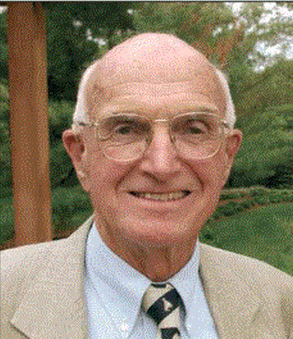Joseph E. Murray facts for kids
Quick facts for kids
Joseph Murray
|
|
|---|---|
 |
|
| Born |
Joseph Edward Murray
April 1, 1919 Milford, Massachusetts, U.S.
|
| Died | November 26, 2012 (aged 93) Boston, Massachusetts, U.S.
|
| Nationality | American |
| Alma mater | College of the Holy Cross (BA) Harvard University (MD) |
| Known for | First successful organ transplant |
| Awards | Nobel Prize in Physiology or Medicine (1990) Golden Plate Award (1991) Laetare Medal (2005) |
| Scientific career | |
| Fields | Plastic surgery, reconstructive surgery, transplantation |
| Institutions |
|
Joseph Edward Murray (born April 1, 1919 – died November 26, 2012) was an American plastic surgeon. He made history by performing the world's first successful human kidney transplant. This amazing operation happened on December 23, 1954. He transplanted a kidney between identical twins named Richard and Ronald Herrick.
In 1990, Dr. Murray received the Nobel Prize in Physiology or Medicine. He shared this important award with E. Donnall Thomas. They were honored for their discoveries about how to transplant organs and cells. Their work greatly helped in treating human diseases.
Contents
Early Life and Education
Joseph Murray grew up in Milford, Massachusetts. His parents were William and Mary Murray. He was a talented athlete in high school. He played football, ice hockey, and baseball very well.
After high school, Murray went to the College of the Holy Cross. He planned to play baseball there. However, his baseball practice times clashed with his science lab classes. He decided to focus on his studies instead. He earned a degree in the humanities, studying philosophy and English.
Later, Murray attended Harvard Medical School. After getting his medical degree, he started his internship. This was at the Peter Bent Brigham Hospital. During this time, he joined the Medical Corps of the U.S. Army.
Medical Career and World War II
Dr. Murray served in the plastic surgery unit. This was at Valley Forge General Hospital in Pennsylvania. There, he worked with a famous plastic surgeon, Bradford Cannon. This experience made him very interested in plastic surgery.
His unit helped thousands of soldiers. These soldiers were wounded during World War II. They worked to fix their disfigured hands and faces. Dr. Murray's interest in transplants grew from helping burn patients. He and his team noticed that skin grafts from other people lasted longer than expected. This suggested that organ transplants might also be possible.
After his time in the military, Murray finished his surgical training. He then joined the surgical team at the Peter Bent Brigham Hospital. He also trained in plastic surgery in New York. In 1951, he returned to Brigham as a surgeon.
Pioneering Organ Transplants
On December 23, 1954, Dr. Murray performed a groundbreaking surgery. It was the world's first successful kidney transplant. The operation took five and a half hours. It happened at the Peter Bent Brigham Hospital. This hospital is now known as Brigham and Women's Hospital.
Dr. J. Hartwell Harrison and other doctors helped him. Murray transplanted a healthy kidney from Ronald Herrick. He gave it to Ronald's identical twin brother, Richard. Richard was very sick with a kidney disease. After the transplant, Richard lived for eight more years.
In 1959, Dr. Murray performed another first. He did the world's first successful allograft. This is a transplant between people who are not identical twins. Then, in 1962, he performed the first kidney transplant using a kidney from a deceased donor.
Advancements in Transplantation
In the years that followed, Dr. Murray became a global leader. He studied transplantation biology. He also researched how to use medicines that stop the body from rejecting new organs. These medicines are called immunosuppressive agents.
In the 1960s, top scientists wanted to work with Dr. Murray. Together, they adapted a new drug called Imuran. This drug, also known as azathioprine, was used for transplants. The discovery of Imuran and other anti-rejection drugs was a huge step. It allowed Dr. Murray to perform transplants from unrelated donors. By 1965, over 65% of patients who received a kidney from an unrelated donor survived.
As a professor at Harvard Medical School, Dr. Murray trained many doctors. They came from all over the world to learn about transplants. He also often performed surgeries in developing countries. For 20 years, he directed the Surgical Research Laboratory at Harvard. He inspired many others to become leaders in transplantation and biology.
He was the chief plastic surgeon at Peter Bent Brigham Hospital until 1986. He also served as chief plastic surgeon at Children's Hospital Boston. He retired from Harvard Medical School in 1986.
Awards and Recognition
In 1990, Dr. Murray received the Nobel Prize in Physiology or Medicine. This honored his pioneering work in organ transplantation.
He was also elected to the National Academy of Sciences. He received many other awards for his important contributions. These included the American Surgical Association's Medal for Distinguished Service. He also received the National Kidney Foundation's Gift of Life Award.
In 1991, he received the Golden Plate Award. In 1996, he became an Academician of the Pontifical Academy of Sciences in the Vatican. In 2005, he received the Laetare Medal. This award recognized his outstanding service to the Catholic Church and society.
Personal Life and Passing
Dr. Murray's father was a well-known lawyer and judge. In June 1945, Joseph Murray married Bobby Link. She was a school teacher and his college sweetheart. They had six children together, three boys and three girls.
Joseph Murray passed away on November 26, 2012. He was 93 years old. He had a stroke at his home near Boston. He died at Brigham and Women's Hospital. This was the same hospital where he had performed the first organ transplant.
See also
 In Spanish: Joseph Edward Murray para niños
In Spanish: Joseph Edward Murray para niños

